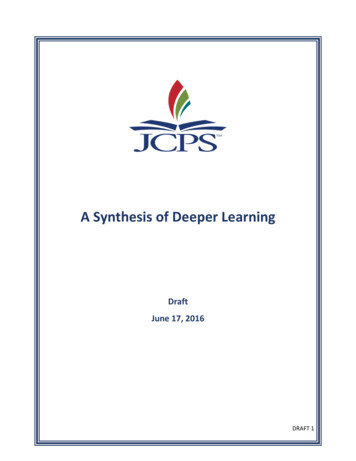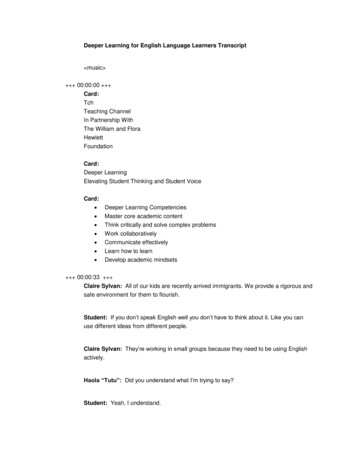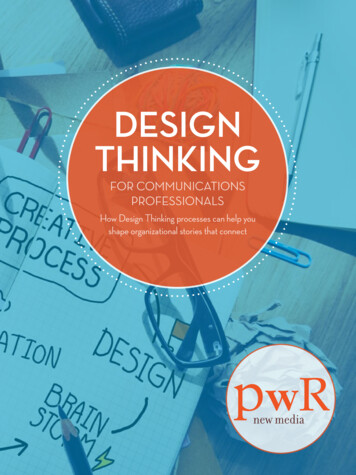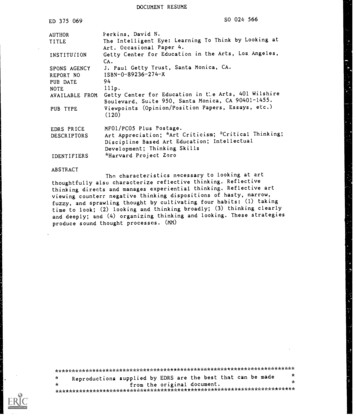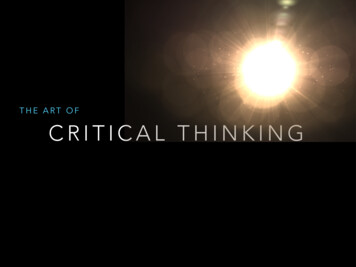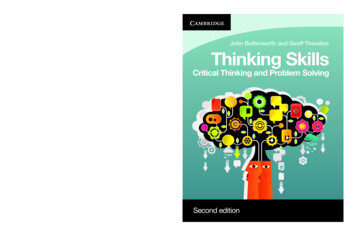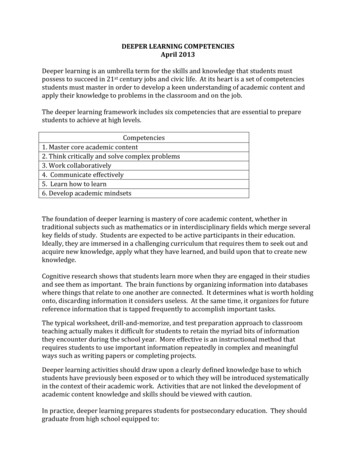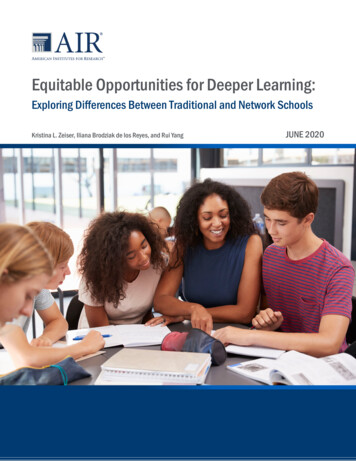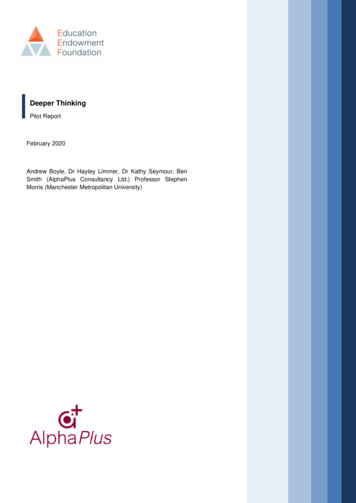
Transcription
Deeper ThinkingPilot ReportFebruary 2020Andrew Boyle, Dr Hayley Limmer, Dr Kathy Seymour, BenSmith (AlphaPlus Consultancy Ltd.) Professor StephenMorris (Manchester Metropolitan University)
The Education Endowment Foundation (EEF) is an independent grant-making charity dedicated to breaking the linkbetween family income and educational achievement, ensuring that children from all backgrounds can fulfil theirpotential and make the most of their talents.The EEF aims to raise the attainment of children facing disadvantage by: identifying promising educational innovations that address the needs of disadvantaged children inprimary and secondary schools in England; evaluating these innovations to extend and secure the evidence on what works and can be made towork at scale; and encouraging schools, government, charities, and others to apply evidence and adopt innovationsfound to be effective.The EEF was established in 2011 by the Sutton Trust as lead charity in partnership with Impetus (formerly ImpetusTrust) and received a founding 125m grant from the Department for Education.Together, the EEF and Sutton Trust are the government-designated What Works Centre for improving educationoutcomes for school-aged children.The pilot was funded by the Education Endowment Foundation (EEF) as part of a joint initiative with the Wellcome Trustwhich aims to generate new evidence about science teaching, with the particular aim of closing the science attainmentand progression gap that exists between disadvantaged pupils and their more affluent peers.For more information about the EEF or this report please contact:Jonathan KayEducation Endowment Foundation5th Floor, Millbank Tower21–24 MillbankSW1P 4QP0207 802 ndowmentfoundation.org.uk
Deeper ThinkingPilot ReportContentsAbout the evaluator . 4Executive summary . 5Introduction . 7Methods . 15Findings . 22Conclusion . 46References . 50Appendix 1: The Deeper Thinking Classroom Pack . 52Appendix 2: Memorandum of Understanding (MOU) . 55Appendix 3: Teacher Information sheet . 60Appendix 4: Theory of Change template . 64Appendix 5: Interview schedule for previous users of the Deeper Thinking Intervention . 65Appendix 6: January Teacher Survey . 66Appendix 7: June Teacher Survey . 70Appendix 8: CPD Evaluation form questions . 78Appendix 9: Observation template . 79Appendix 10: Interview schedule for Deeper Thinking Lead Teacher . 81Appendix 11: Focus Group Schedule for Deeper Thinking Teachers . 84Appendix 12: Survey Tables . 863
Deeper ThinkingPilot ReportAbout the evaluatorAlphaPlus Consultancy Ltd. is one of the UK’s leading educational consultancies drawing on the professionalexperience of a team whose work spans the public and private sectors, covering education, assessment andevaluation. We can draw upon a team of over 400 associates, each of whom brings many years’ experience ineducation, covering both schools and post compulsory education, as well as roles in many of the supporting agenciesand government departments. We are actively engaged with the latest educational developments, on both a strategiclevel, through our research and evaluation projects for UK government, and at a practical level, through theexperience of our wider team in all aspects of educational development and change.We have an international reputation for robust and meaningful evaluations, which support our clients to understandthe impact on their stakeholders of policy change and/or interventions. We work in collaboration with our clients toensure that evaluation findings are evidence based and useful. We ensure that our data collection, analysis andinterpretation is undertaken with a solid understanding of the stakeholder context and within ethical guidelines.Our team has expertise in assessment, evaluation and statistics, fieldwork, and evidence gathering – but we are alsoexcellent communicators, speaking and writing clearly and accurately and giving messages that are to the point andfree of jargon. We provide realistic and evidence-based reports for our research and evaluation clients.Contact detailsAndrew BoyleDirector of researchAlphaPlus Consultancy Ltd.Andrew.boyle@alphaplus.co.uk4
Deeper ThinkingPilot ReportExecutive summaryThe projectThe Deeper Thinking programme aims to improve outcomes in GCSE science by encouraging pupils to use a varietyof metacognitive strategies including the Structure of Observed Learning Outcomes (SOLO) Taxonomy and conceptmapping and revision strategies. SOLO Taxonomy provides pupils with a five-stage, visual model that aims to changehow they think about scientific understanding. It encourages learners to link scientific knowledge together and apply itto different contexts. Concept-mapping is also deployed and provides pupils with blank laminated hexagons to populatewith scientific concepts before discussing how they link together. Alongside these strategies, Deeper Thinking alsoencourages the use of revision techniques, including practice testing and distributed practice.Carmel Education Trust developed this approach, which specifically targets two types of GCSE science question: thosethat require an extended answer and those relating to the ‘required’ practicals. Schools involved receive four CPDsessions comprising one day of leadership training for senior leaders followed by three twilight training sessions forscience teachers. Teachers are also provided with resource packs and an online portal to support delivery.Twelve schools in the North East and North Yorkshire took part in this pilot, which ran from January to June 2019. Theyimplemented the strategies with their Year 10 pupils in a condensed version of the programme (which would ordinarilybe delivered for two years across Year 10 and 11).The pilot was funded by the Education Endowment Foundation (EEF) as part of a joint initiative with the Wellcome Trustwhich aims to generate new evidence about science teaching, with the particular aim of closing the science attainmentand progression gap that exists between disadvantaged pupils and their more affluent peers.How was the pilot conducted?The pilot aimed to examine whether Deeper Thinking could be summarised in a plausible, doable, testable, andmeaningful Theory of Change, before exploring whether the programme may improve teacher practice and perceivedpupil behaviour. The evaluation also aimed to discover whether the intervention is sufficiently different to currentpractice, alongside exploring how feasible and ready for trial the programme is.A mixed-methods approach was taken to data collection combining evidence from interviews, observations, surveys,and administrative data, in addition to an analysis of selected GCSE science exam paper questions.Overview of findingsSummary of pilot findingsQuestionFindingCommentIs there evidence to support the Theory ofChange?MixedThere is some evidence of positive changes to teaching practice andperceptions of an impact on pupils, but some teachers were alreadyusing similar techniques.The programme has low costs, is easy to set up, and does not requireaccess to IT.Was the approach feasible?MixedFidelity to the programme implementation and delivery may havebeen a cause for concern as a substantial proportion of teachersreported that they were not consistently using the SOLO Taxonomyplacement and quick concept-mapping hexagons together.Some teachers reported that strategies may support lower-abilitylearners, but others reported that it was a challenge to apply theDeeper Thinking intervention to lower-attaining pupils and thoselacking the skills/capacity to work independently.Is the approach ready to be evaluated in atrial?NoThe delivery partner would need to adapt the Deeper Thinkingclassroom packs and training materials to better prepare teachers oflower-attaining and disruptive classes.5
Deeper ThinkingPilot ReportThe findings were mixed. The pilot found that the Deeper Thinking intervention could be summarised as a distinctintervention, with a well-grounded, doable, testable, and meaningful Theory of Change. However, while there was someevidence of positive changes to teaching practice, there is only mixed evidence that the programme would improveGCSE science outcomes. Some teachers did report that the programme led to positive changes in their practice, suchas identifying scientific misconceptions more quickly, implementing a greater focus on practicals and writing style, andfostering links between different scientific content. Some teachers also appeared to be using the techniques beyondthe pupils involved in the pilot, while others reflected that the intervention may have supported pupils to communicatescientific knowledge and make their own links between concepts. Two of the case studies also suggested that DeeperThinking may reduce teacher planning and marking workload (although this was not explicitly measured in the pilot).However, the pilot also suggests that many teachers may already be using techniques which are similar to thosedeployed in Deeper Thinking. Some teachers also reported that it was a challenge to deliver the programme to, and toelicit outcomes from, lower-attaining pupils and those lacking the skills and capacity to work independently. While someteachers reported that certain strategies (such as quick concept-mapping) may support lower-attaining learners, otherssuggested that lower-ability pupils may find the programme more challenging. Given the mission of the EEF—and theaims of the funding round—to narrow the attainment gap, this may be a concern.Although the programme has low costs and does not require access to IT, the pilot identified challenges aroundfeasibility. There may have been evidence that a substantial proportion of teachers did not consistently deliver theprogramme as intended as teachers may have selected different strategies from the programme rather than deliveringthe suite of techniques together. The delivery team would argue that this still represented delivery as intended as theymaintain that teachers could have delivered the strategies flexibly. Development may be required to define more clearlywhat teachers are expected to deliver. The training was rated highly by participants. Although some noted that it couldhave been condensed and suggested improvements—such as providing more training materials—more than threequarters of respondents found the training to be ‘helpful’ or ‘very helpful’.The intervention is not ready to be evaluated in a trial as development would be required to ensure that lower-attainingpupils are able to access the intervention.The pilot also examined whether it would be possible for an evaluation team to conduct a future trial of the approach.An analysis of AQA exam papers suggested that there are a sufficient number of relevant questions included in thesample papers analysed for a trial to measure the impact of the programme. However, the ability to monitor the use ofsimilar activities in a control group of schools is anticipated to prove challenging as the Deeper Thinking interventionincludes some activities that many teachers use already. Whilst the Deeper Thinking intervention is unique in that itcombines several approaches, these do exist in isolation, therefore the apparent lack of difference to current practicecould also make demonstrating an impact more challenging.6
Deeper ThinkingPilot ReportIntroductionInterventionThe description below refers to the intended implementation of this intervention. For practical reasons, the followingchanges and conditions applied to the current piloting of the intervention: The pilot was delivered by the Carmel Education Trust across 12 schools in the North East and North Yorkshire.This number of schools is comparable to other pilot trials and was considered sufficient to allow for someconclusions to be drawn across a variety of schools whilst keeping the resources required to deliver the pilotmanageable. The pilot was a shortened version of what is intended to be a two-year intervention running from the beginningof Year 10 through to the GCSE exam period in Year 11. The pilot ran from January to June 2019 and theintervention was used with Year 10 pupils only.1. Brief name: Deeper Thinking.2. Why (rationale/theory)? Carmel Education Trust's research suggests that pupil performance in scienceexaminations is limited by poor responses to extended answer questions (those worth typically four to six marks) andquestions around experiments that took place in class (also known as ‘required’ practicals). Performance appears to belimited by the pupils’ inability to respond correctly to the command words used in examinations. Some pupils, particularlythe least able and those with lowest literacy (of which a high proportion are disadvantaged pupils) often do not attemptto answer extended answer questions. Those who attempt the questions often do not connect their knowledge togetherin a way that answers the question. Many teachers appear not to have suitable techniques, tools, or programmes toprepare the pupils well for these questions. Revision for examinations is often limited and occurs late in the GCSEprogramme.Deeper Thinking aims to: improve pupil performance at GCSE by intervening over one to two years;develop pupils’ understanding of the marking and question-setting process for GCSE science;develop a deeper understanding in pupils of the ‘required’ practicals; andimprove pupil revision strategies.3. Who (recipients)? Pupils in Years 10 and 11 receive the intervention as part of their GCSE science programme.4. What (materials)? Teachers receive materials, including templates and guidance documentation, to support thedelivery of Deeper Thinking approaches. These approaches aim to work together to improve:1.2.performance in extended answer and analysis questions; andreasoning around the ‘required’ practicals.The approaches include the Structure of Observed Learning Outcomes (SOLO) Taxonomy, concept-mapping, andrevision techniques.The SOLO Taxonomy is a model that aims to change how pupils frame their scientific understanding. It categorisespupils’ responses to a question, in this case a mock extended answer science exam question, according to five levelsof sophistication ranging from no understanding to a complex understanding of how several pieces of information canbe linked together and applied to different contexts. These are formally labelled as: prestructural—the question is not understood;unistructural—one piece of information is identified;multistructural—several pieces of information are identified but they are treated independently;relational—the different pieces of information are linked together; and7
Deeper ThinkingPilot Report extended abstract—being able to reconceptualise the information and apply it to a different question (Biggsand Collis, 1982).Deeper Thinking encourages pupils to understand and then move up the SOLO levels. Although the SOLO Taxonomyis arguably the most visible part of the programme, Deeper Thinking involves the combination of the SOLO Taxonomywith: developing an understanding in pupils of command words used in examinations (for example, ‘describe’ and‘explain’);quick concept-mapping—based on the use of blank laminated hexagon tiles that can be written on with drywipe pens and flexibly placed next to one another; pupils populate the tiles with scientific concepts, beforediscussing how they link together; andan approach to revision informed by Dunlosky et al.’s (2013) analysis of the utility of learning strategies.This is summarised in Figure 1.Figure 1: What is 'Deeper Thinking'?Teachers are provided with a set of classroom packs (approximately 15) so pupils can work in pairs, with one pack perpair. Each classroom pack provides 22 blank laminated hexagons, three dry-wipe pens for populating the hexagons, acloth to clean the hexagons, a rubric, and a SOLO Taxonomy placemat all held in a plastic folder (see Appendix 1).The SOLO Taxonomy placemat summarises the SOLO levels in a language that is more pupil friendly than theacademic terms used by Biggs and Collis (1982) whilst the rubric provides a template in which they can write notes thatjustify the level of their answer. The packs are typically used in relation to extended answer or practical mock examquestions.5. What (procedures)? The programme involves training teachers to use the Deeper Thinking techniques within theirscience classes. In the intended full intervention, catch-up training is scheduled to take place in the second year ofimplementation to accommodate changes of staffing.6. Who? Within each school there is a Deeper Thinking lead who coordinates the intervention and science teacherswho deliver the intervention to pupils. A team of trainers from the Carmel Education Trust deliver the science teachertraining.8
Deeper ThinkingPilot Report7. How (mode of delivery)? The Deeper Thinking lead is trained in key elements of the approach through a one-daytraining event. All schools then receive three departmental twilight training sessions (two hours each) to be attended byall the science teachers taking part. Teachers are also able to access an online learning portal that provides furthermaterials such as videos of exemplar lessons demonstrating the Deeper Thinking techniques. Teachers are alsoencouraged by Carmel to upload reflective paragraphs here to capture their learning.In a typical Deeper Thinking session applied to an extended answer question, some variant on the following processtypically takes place: Pupils are presented with an extended answer question from an exam paper.They rate themselves on the SOLO Taxonomy placemat diagram by placing their pen on the stage that bestrepresents their current ability to answer the question.The teacher leads a short discussion on the wording of the exam question to reinforce what it is asking themto do and how it fits with the SOLO Taxonomy placemat and the hexagons.Pupils then engage in quick concept-mapping where they work in pairs to populate the blank hexagons withkey words that relate to the question. Each pupil pair works with 22 hexagons.In the same pairs, the pupils then discuss links between the hexagons in relation to the extended answer.The teacher visits each group and has a discussion on how the hexagons link together; this involves askingpupils questions rather than giving them answers.There is some class-level discussion on the insight that is being generated. Sometimes pupils look at theconcept maps of other groups and note down what they might be missing.Pupils then individually write an answer to the extended answer question.They rate themselves again on the SOLO Taxonomy placemat diagram by placing their pen on the stage thatbest represents their current ability to answer the question.The exercise concludes with some form of acknowledgement from the teacher and from the pupilsthemselves that they knew more than they thought and were able to answer a difficult exam question.The extent to which the lesson focuses on the wording of the question, mark schemes, and alternative contexts is atthe teacher’s discretion.It is also recommended that a variant on this is applied to a science practical; this tends to be done in the lessonfollowing the practical so the pupils can reflect on the activity rather than as the practical is taking place.A further session where pupils explore evidence-based revision techniques informed by the learning strategies reviewedby Dunlosky et al. (2013) is also provided. This does not involve the hexagons but aims to increase pupils’ metacognitiveawareness with respect to the activities they may be engaging in when revising for their science GCSE. During thesesessions, the teacher leads a discussion on the different techniques that they use to revise for exams. The teacher thenmoves on to discuss the relative utility of the different learning strategies evaluated by Dunlosky et al. (2013). Thisprocess aims to flag to the learners that some of the techniques they may be relying on, such as highlighting and rereading text, could be replaced with other learning strategies such as practice testing and interleaved practice.8. Where (setting)? Regular classrooms in participating schools.9. When and how much (dosage)? Pupils receive the intervention at regular intervals (approximately once every twoto four weeks) over the two-year period. The practicals are distributed throughout the course and practice of extendedanswer questions takes place at least half-termly.10. Tailoring. Schools fit the programme around their usual work in class relating to the required practicals and practiceexaminations. The aspect of the intervention delivered (that is, the focus on extended answer questions or practicals)is partly dependent on the aspect of the curriculum being taught.Background evidenceThis pilot project was jointly funded by the Wellcome Trust and the EEF as part of the Improving Science Educationround.9
Deeper ThinkingPilot ReportEach of the three key components of the Deeper Thinking intervention is based on research evidence, as discussedbelow.The SOLO TaxonomyDeveloped by Biggs and Collis (1982), SOLO Taxonomy breaks down stages of learning into five steps (prestructural,unistructural, multistructural, relational, and extended abstract). Pupils are taught these five steps and are encouragedto apply them to their scientific knowledge and to structure their responses through them. In addition, pupils are taughta series of connected metacognitive approaches, including concept-mapping and constructing success criteria to beused when appraising their work.Previous research primarily applies the SOLO Taxonomy to undergraduate students rather than pupils of secondaryschool age (for example, Carew and Mitchell, 2002). This may partly reflect that the extended abstract level of the SOLOTaxonomy requires higher-level metacognitive skills that may be more appropriate for university students. Nevertheless,Minogue and Jones (2009) use the SOLO Taxonomy as a way of measuring the impact of a computer-based learningenvironment amongst middle school science students in the U.S., suggesting it can be a useful framework for workingwith this age group.Revision skillsThe use of evidence-based revision techniques is informed by the work of Dunlosky et al. (2013) who distinguishedbetween ten different learning strategies. Whilst Dunlosky et al. (2013) did not focus primarily on revision techniques,the learning strategies that they evaluated can be closely aligned to the revision strategies applied by GCSE pupils: elaborative interrogation—explaining why a fact/concept is true;practice testing—self-testing or taking practice tests of to-be-learned materials;self-explanation—explaining how new information is related to already known information;summarisation—writing summaries of to-be-learned text;highlighting/underlining—marking potentially important portions of texts while reading;distributed practice—a schedule of practice that spreads out study activities over time;rereading—restudying text material again;key word memory techniques—using keywords to aid the recall of information;imagery for text—forming mental images of text materials; andinterleaved practice—a schedule of practice that jumps between alternating topics.Dunlosky et al. (2013) conclude that not all learning techniques are equally effective for improving pupil learning andassign them a utility rating ranging from low to high. Low utility techniques include summarisation,highlighting/underlining, keyword mnemonics, imagery for text, and rereading. Techniques rated as having moderateutility are elaborative interrogation, self-explanation, and interleaved practice. Practice testing and distributed practiceare considered to have high utility. The Deeper Thinking intervention encourages both teachers and pupils to considerhow they are revising and setting revision tasks and to adopt the higher utility approaches.Quick concept-mappingThe use of the laminated hexagons is based on the rationale that quick concept maps are an effective learning tool.The ‘quick’ aspect comes from the way the Deeper Thinking hexagons are laminated, which allows for amends to bemade quickly as the hexagons can be wiped clean and edited. Furthermore, the individual hexagons can be physicallymoved next to one another, which is relatively quick compared to a hand drawn concept map diagram that may requiremore effort to rework any changes. A meta-analysis (using international data) by Nesbit and Adescope (2006) suggeststhat the use of concept maps is associated with an increase in knowledge retention and transfer when compared toother activities such as reading text passages. The authors also conclude that concept maps may suit collaborative andcooperative learning as they make economical use of text that can be viewed by a small group. They cite van Boxtel etal. (2002) who found that concept-mapping was a successful collaborative learning tool amongst physics students aged15 to 16, with learning outcomes positively related to the quality of student interaction and level of elaboration indiscussions. Meanwhile, data from a review of 35 higher education medical papers suggests that concept maps providefour key functions: they promote meaningful learning, provide an additional resource for learning, enable instructors to10
Deeper ThinkingPilot Reportprovide feedback, and assess learning (Daley and Torre, 2010). Whilst the present study draws on a different sampledemographic, there is no evidence to suggest that these findings would not apply to younger learners within a sciencecontext.Existing evidence for the interventionMore generally, the Deeper Thinking intervention touches on several of the recommendations in the EEF’s ImprovingSecondary Science guidance, namely: helping pupils direct their own learning by explicitly teaching pupils to monitor and evaluate their learning (viathe SOLO Taxonomy placemat that requires the learners to reflect on what they think they know about a topicbefore and after the lesson);supporting pupils to retain and retrieve knowledge by providing opportunities for pupils to retrieve and elaborateon the knowledge they have previously learnt (via the quick concept-mapping hexagons);using practical work purposefully and as part of a learning sequence (via the sub-focus on required practicalsand exam questions that apply to them);developing the language of science, including reference to the links between words; andusing structured feedback to develop pupils’ thinking, which requires finding out what pupils understand.The intervention has been developed by the Carmel Education Trust over several years. In 2017/2018, a small pilotintervention of its current format was tested in six schools. This earlier evaluation, carried out by the Trust, included anexploratory analysis of pre- and post-tests which suggested a potentially positive impact on science outcomes.Policy and practice contextWhilst the evaluation did not find any recent government policies relating to the SOLO Taxonomy, a 2014 governmentreport by the National College for Teaching and Leadership 1 acknowledged that the SOLO Taxonomy in combinationwith the materials developed by Pam Hook were widely used in schools in New Zealand and when adopted in a selectionof U.K. schools, was found to be a useful learning approach. Specifically:‘The materials and approach were found to be valuable both to assist teachers in their planning and pupils in theiractive engagement in learning activities, leading to enhanced peer and self-assessment skills being developed by thepupils and more differentiated approaches for personalising learning’ (p. 13, Lilly et al., 2014).The SOLO Taxonomy is a relatively well-known approach and is likely to be used in some schools already; this isanecdotally supported by some simple internet searches. Nevertheless, the evaluation is unable to ascertain howwidespread its use is, particularly amongst GCSE scienc
Deeper Thinking Pilot Report 6 The findings were mixed. The pilot found that the Deeper Thinking intervention could be summarised as a distinct intervention, with a well-grounded, doable, te
